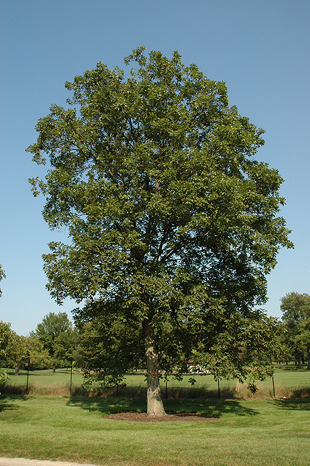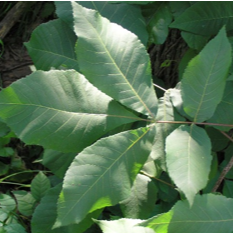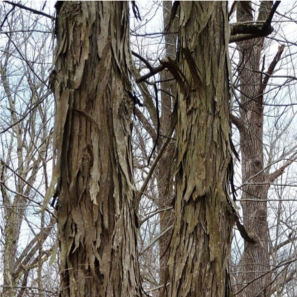
Shagbark Hickory
Carya ovata
Family: Juglandaceae
Leaf Type: Deciduous
Mature Height: ~25 m (~80 ft)
Fall Color: Red-orange
Native Range: Shagbark hickories have a native range from the Midwest up to the northeastern United States.

Features
The leaves of shagbark hickories are compound with five, sometimes seven, leaflets. The entire leaf is around 11 inches long. The leaflet on the end, the terminal leaflet, is the largest. The underleaf is slightly paler than the green leaf on top. The edges of the leaflets are slightly hairy which is unique among hickories. The fruit of all trees in the walnut family are nutritious nuts encased in a hard, outer husk. Shagbark hickories have a large, round fruit with a thick green husk , or outer covering, that darkens when mature. The husk opens to release a four-sided, sweet nut. The nuts were a food source for Native Americans along with wildlife.
We recommend not sampling the fruits & nuts of the trees and plants here at Adventure Science Center. The most distinctive trait of the shagbark hickory is the bark, from which it gets its name. The bark of young trees is smooth and gray with lighter stripes, while older trees have very shaggy bark that curls in long, wide strips.

Fun Facts
● The most distinctive trait of the shagbark hickory is the bark, from which it gets its name.
● The wood of shagbark hickories has a variety of uses including smoking meats, making drumsticks, and, historically, making bows for Native American hunters.
● The tallest measured shagbark hickory stands at over 150ft (46m) and is located in Savage Gulf, TN, about two hours from the science center. That is taller than 3.5 brachiosaurus dinosaurs stacked on top of each other!
“If Trees Could Sing” is a project of The Nature Conservancy that highlights several recording artists and demonstrates the importance of trees. Check out what Deanie Richardson has to say about shagbark hickories.
Learn More

Did you know that trees provide homes for animals, keep us cool and clean our air? Click here to learn more about the benefits that trees provide to us and our world.

